Macronutrient Deficiencies in Plants:
In the realm of plant health, macronutrients play an indispensable role. They are the key elements that plants require in larger quantities for growth, development, and overall well-being. Among these, nitrogen (N), phosphorus (P), and potassium (K) stand out as the primary macronutrients. However, a deficiency in any of these can lead to significant health issues in plants. Understanding the signs of these deficiencies, where they manifest, and how to rectify them is crucial for maintaining plant health and a happy healthy garden.
Nitrogen Deficiency:
Nitrogen is fundamental for plant growth, being a key component of chlorophyll, the compound plants use in photosynthesis. It also forms part of the amino acids in plant proteins, vital for cell growth and repair. A nutrient deficiency in nitrogen leads to inhibited growth and pale, yellowed foliage, as plants struggle to synthesize enough chlorophyll. This can significantly reduce a plant’s ability to photosynthesize effectively, impacting its overall health and productivity.
- What to Look For:
- Older leaves turn yellow or light green.
- Stunted growth, smaller than usual leaves.
- Reduced flowering or fruit production.
- Where You’ll See It:
- Mainly in the older leaves at the bottom of the plant.
- Generalized pale green color throughout the plant.
- Slow overall growth and development.
- How to Fix It:
- Apply a nitrogen-rich fertilizer, such as urea or ammonium nitrate.
- Use organic options like composted manure or blood meal.
- Regularly test soil and adjust nitrogen levels accordingly.
- What to Look For:
Phosphorus Deficiency:
Phosphorus plays a critical role in energy transfer within the plant, being a part of ATP, the energy currency of cells. It is also involved in the development of DNA and RNA. Phosphorus nutrient deficiencies in plants typically results in stunted growth and delayed maturation. The distinct purpling of leaves is a tell-tale sign, often a result of an imbalance in certain phytonutrients. This deficiency can drastically affect the plant’s ability to complete its lifecycle, especially impacting flower and fruit formation.
- What to Look For:
- Leaves may develop a purplish tint, particularly on the underside.
- Stunted growth and delayed maturity.
- Poor development of fruits or flowers.
- Where You’ll See It:
- Both older and younger leaves can be affected.
- Darker than normal leaf coloration.
- Weak and spindly stem growth.
- How to Fix It:
- Use a phosphorus-rich fertilizer like superphosphate.
- Employ bone meal or rock phosphate for organic solutions.
- Balance phosphorus application with other nutrients to avoid excess.
- What to Look For:
Potassium Deficiency:
Potassium is essential for regulating various plant processes, including water and nutrient transport, enzyme activation, and photosynthesis. It is key to maintaining overall plant health and resistance to stress factors like diseases and drought. Symptoms of potassium nutrient deficiencies in plants include yellowing or browning leaf edges and weakened stems. Plants become more susceptible to environmental stresses and pathogens, and their growth and reproductive capabilities are often severely hampered.
- What to Look For:
- Yellowing or browning at the edges of older leaves.
- Leaves may curl and appear scorched.
- Weak stems and increased susceptibility to diseases.
- Where You’ll See It:
- Starts with older leaves and progresses upwards.
- Overall reduced vigor and resilience.
- Flowering and fruiting may be reduced or of poor quality.
- How to Fix It:
- Apply a potassium-rich fertilizer, such as potassium sulfate.
- Incorporate potash or wood ash for organic gardening.
- Ensure balanced fertilization to prevent nutrient lockout.
- What to Look For:
Micronutrient Deficiencies in Plants:
- Iron (Fe): Essential for chlorophyll synthesis and enzyme function.
- Manganese (Mn): Important for photosynthesis, respiration, and nitrogen assimilation.
- Zinc (Zn): Plays a role in growth hormone production and enzyme systems.
- Boron (B): Necessary for cell wall formation and reproductive development.
- Copper (Cu): Involved in photosynthesis, respiration, and lignin synthesis.
- Molybdenum (Mo): Crucial for nitrogen fixation and conversion of nitrates into amino acids.
These micronutrients are needed in smaller quantities than macronutrients like nitrogen, phosphorus, and potassium, but they are just as essential for plant growth and development. Deficiencies or imbalances in these micronutrients can lead to various symptoms and health issues in plants, as detailed in the guide. Regular soil testing and careful observation of plant symptoms are important for identifying and correcting these deficiencies.
Calcium Nutrient Dificiencies in Plants:
- What to Look For:
- New leaves are misshapen or stunted.
- Blossom end rot in fruits, like tomatoes.
- Leaves may have necrotic spots or curled edges.
- Where You’ll See It:
- Mainly in new growth, as calcium is not mobile within the plant.
- Distorted or irregular growth patterns.
- Poor root development and overall frailty in young plants.
- How to Fix It:
- Add lime to acidic soils to increase calcium levels.
- Use calcium nitrate or calcium chloride fertilizers.
- Ensure consistent watering to improve calcium uptake.
- What to Look For:
Magnesium Nutrient Dificiencies in Plants:
- What to Look For:
- Older leaves turn yellow between the veins (interveinal chlorosis).
- Leaf tips may curl upwards and become brittle.
- Reduced fruit yields and poor growth.
- Where You’ll See It:
- First appears in older leaves.
- Gradual progression to middle-aged leaves.
- Plants may seem less robust and healthy.
- How to Fix It:
- Apply magnesium sulfate (Epsom salts) to the soil.
- Use a balanced fertilizer that includes magnesium.
- Check soil pH to ensure it’s not too acidic or alkaline, which affects magnesium availability.
- What to Look For:
Sulfur Nutrient Dificiencies in Plants:
- What to Look For:
- Young leaves turn yellow, unlike nitrogen deficiency which affects older leaves.
- Stunted growth and delayed flowering.
- Leaves may become more erect than normal.
- Where You’ll See It:
- In new growth since sulfur is not easily moved within the plant.
- Overall plant color appears lighter than normal.
- Reduced size and number of leaves.
- How to Fix It:
- Apply sulfur-containing fertilizers like ammonium sulfate.
- Use elemental sulfur in soils with high pH.
- Integrate sulfur-rich organic matter like composted leaves.
- What to Look For:
Iron Nutrient Dificiencies in Plants:
- What to Look For:
- Young leaves turn yellow with very small green veins (interveinal chlorosis).
- In severe cases, the entire leaf may turn completely yellow or white.
- Reduced flowering and fruiting.
- Where You’ll See It:
- Primarily in new growth.
- Starts at the tips and margins of young leaves.
- Can lead to overall reduced plant vigor.
- How to Fix It:
- Apply iron chelates to the soil.
- Use foliar sprays for quick iron absorption.
- Adjust soil pH, as high pH can lock up iron.
- What to Look For:
Manganese Nutrient Dificiencies in Plants:
- What to Look For:
- Interveinal chlorosis in young leaves, similar to iron but less pronounced.
- Brown spots or necrotic patches on leaves.
- Stunted root growth and reduced seed production.
- Where You’ll See It:
- Affects younger leaves first.
- Pale green coloration in young leaves.
- Overall stunted growth, especially in new shoots.
- How to Fix It:
- Apply manganese sulfate to the soil.
- Ensure proper soil pH, as extreme pH can affect manganese availability.
- Use foliar sprays for immediate manganese uptake.
- What to Look For:
Zinc Nutrient Dificiencies in Plants:
- What to Look For:
- Reduced leaf size and stunted growth.
- Interveinal chlorosis and leaf distortion.
- Delayed maturity and reduced yield.
- Where You’ll See It:
- Typically in new growth.
- Shortening of internodes leading to a rosette-like appearance.
- Reduced leaf bud development and flowering.
- How to Fix It:
- Apply zinc sulfate to the soil.
- Use chelated zinc formulations for better absorption.
- Correct the soil pH to improve zinc availability.
- What to Look For:
Boron Nutrient Dificiencies in Plants:
- What to Look For:
- Death of growing points and abnormal growth.
- Thickening or brittleness of leaves.
- Hollow stems and fruit, and flower sterility.
- Where You’ll See It:
- Affects both new and mature tissues.
- Corky or cracked stems and petioles.
- Poor pollen viability and seed set.
- How to Fix It:
- Apply borax or other boron-containing fertilizers.
- Be cautious with application rates as boron can be toxic in high amounts.
- Ensure even distribution of boron in the soil.
- What to Look For:
Copper Nutrient Dificiencies in Plants:
- What to Look For:
- Young leaves may appear dark green and twisted.
- Reduced growth and wilting of new shoots.
- Poor seed production and fruit development.
- Where You’ll See It:
- Primarily in new growth.
- Stem dieback and general plant weakness.
- Inability of plant to recover from wilting.
- How to Fix It:
- Apply copper sulfate or chelated copper fertilizers.
- Include copper in a balanced fertilization program.
- Correct soil pH to improve copper uptake.
- What to Look For:
Molybdenum Nutrient Dificiencies in Plants:
- What to Look For:
- Yellowing of older leaves, often confused with nitrogen deficiency.
- Leaves may become narrow and distorted.
- Poor formation of flowers and fruits.
- Where You’ll See It:
- Generally starts in older leaves.
- Leaf margins roll and become pale.
- Reduced nitrogen fixation in legumes.
- How to Fix It:
- Apply molybdenum-containing fertilizers like sodium molybdate.
- Ensure appropriate soil pH as molybdenum availability decreases in acidic soils.
- Use foliar sprays for quicker correction of molybdenum deficiency.
- What to Look For:
Now you know the importance of both macronutrients and micronutrients in plant health. This guide equips you with the knowledge to identify and address various nutrient deficiencies, which is crucial for maintaining healthy, vigorous plants. Regular soil testing, careful observation of plant symptoms, and balanced fertilization are key strategies for preventing and correcting nutrient imbalances in plants. Understanding these nutrient deficiencies and their remedies will empower you to ensure the optimal growth and health of your plants, leading to lush, productive gardens and crops.
Nutrient deficiencies can have a detrimental effect on plant growth. Also see Fertilizers Explained – Macronutrients, Micronutrients and Slow-release Fertilizers
 |


